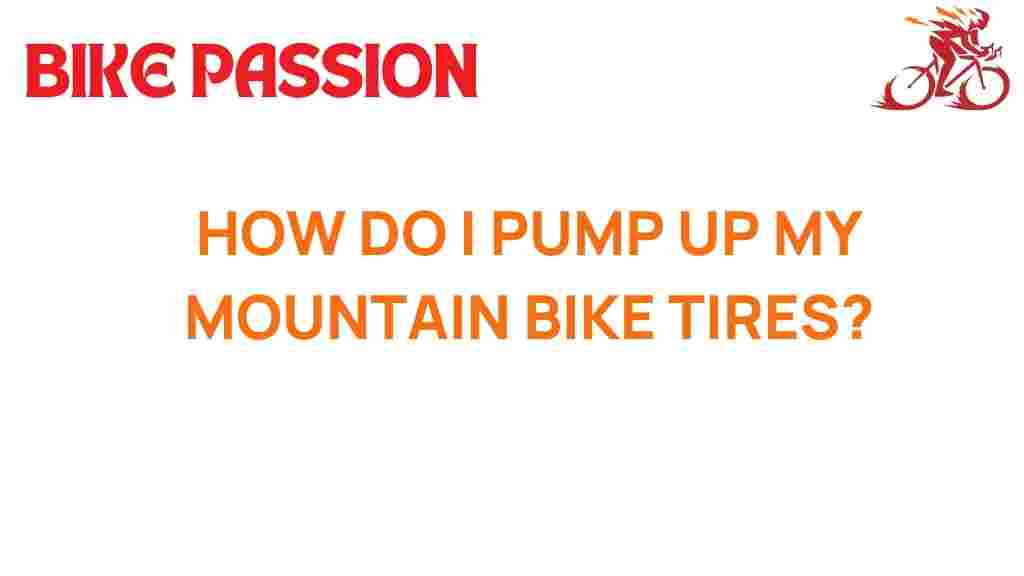Mastering Tire Pressure: The Key to Optimizing Your Mountain Bike
When it comes to mountain biking, one of the most crucial aspects of bike maintenance is managing your tire pressure. Proper tire pressure not only enhances your bike’s performance but also ensures safety while riding through various terrains. Whether you’re navigating rocky trails or cruising down smooth paths, understanding how to optimize your tire pressure can significantly impact your overall adventure. In this article, we will explore the importance of tire pressure, provide cycling tips for different riding conditions, and offer troubleshooting advice for common issues related to tire pressure.
Understanding Tire Pressure and Its Importance
Before diving into the specifics of adjusting tire pressure, it’s essential to understand what tire pressure is and why it matters:
- Tire Pressure Defined: Tire pressure is the measure of air inside your tire, expressed in PSI (pounds per square inch). It affects how your tire interacts with the ground.
- Impact on Performance: The right tire pressure ensures better traction, improved handling, and reduced rolling resistance. This means you can climb hills more efficiently and navigate tricky descents with more control.
- Safety Considerations: Under-inflated tires can lead to pinch flats, while over-inflation can reduce traction and increase the risk of blowouts, especially on rough terrain.
How to Check and Adjust Tire Pressure
Now that we understand the significance of tire pressure, let’s break down the steps to check and adjust it effectively:
Step 1: Gather Your Tools
To check and adjust your tire pressure, you will need:
- A reliable pressure gauge
- A compatible pump with a pressure gauge
- Your mountain bike
Step 2: Know Your Ideal Tire Pressure
Check your bike’s sidewall for the recommended tire pressure range, usually listed in PSI. The optimal pressure may vary based on:
- Your weight
- Your riding style
- The type of terrain
Step 3: Measure Tire Pressure
Using the pressure gauge, check the current tire pressure by:
- Removing the valve cap from your tire.
- Pressing the gauge onto the valve stem to get a reading.
- Recording the PSI for future reference.
Step 4: Inflate or Deflate as Needed
Based on your measurements, adjust your tire pressure:
- If the pressure is low, use the pump to inflate your tire to the recommended PSI.
- If the pressure is too high, release some air by pressing the valve stem until you reach the desired level.
Step 5: Recheck Tire Pressure
After adjusting, measure the tire pressure again to ensure it’s within the ideal range. Replace the valve cap securely to prevent air loss.
Adapting Tire Pressure to Riding Conditions
Your riding conditions significantly influence how you should set your tire pressure. Here are some tips based on various terrains:
1. Rocky and Technical Trails
For rocky terrains, lower tire pressure improves traction and absorbs shocks:
- Recommended Pressure: 22-26 PSI
- Benefits: Enhances grip and comfort on uneven surfaces.
2. Smooth and Fast Trails
On smoother paths, higher tire pressure can reduce rolling resistance:
- Recommended Pressure: 26-30 PSI
- Benefits: Increases speed and efficiency on well-maintained trails.
3. Wet or Slippery Conditions
In wet conditions, lower tire pressure helps maintain grip:
- Recommended Pressure: 20-24 PSI
- Benefits: Reduces the likelihood of slipping and improves control.
4. Climbing Steep Hills
For steep climbs, maintaining a balance is key:
- Recommended Pressure: 24-28 PSI
- Benefits: Provides traction while avoiding excessive rolling resistance.
Common Tire Pressure Issues and Troubleshooting Tips
Even with regular maintenance, tire pressure issues can arise. Here are some common problems and how to troubleshoot them:
1. Frequent Flats
If you’re experiencing frequent flats, consider the following:
- Check for sharp objects in your tires.
- Ensure your tire pressure is not too low, as this can lead to pinch flats.
- Inspect for signs of wear or damage on your tires.
2. Poor Traction
Struggling with traction could be a sign of incorrect tire pressure:
- Reassess your pressure based on current riding conditions.
- Consider experimenting with lower pressures for better grip.
3. Bouncing on Rough Terrain
If your ride feels bouncy on rough trails, you may be over-inflated:
- Lower your tire pressure to allow for more contact with the ground.
- Test adjustments systematically to find your ideal comfort level.
4. Tire Wear
Uneven tire wear can indicate improper pressure management:
- Check for signs of wear on the tire edges; this may suggest over-inflation.
- Look for center wear, which can indicate under-inflation.
Conclusion
Mastering tire pressure is a fundamental aspect of optimizing your mountain bike for different riding conditions. By understanding how to check, adjust, and troubleshoot tire pressure, you can enhance your bike’s performance, ensure your safety, and fully enjoy your biking adventures. Remember that each riding experience may require different tire settings, so don’t hesitate to experiment to find what works best for you.
For more cycling tips and bike maintenance advice, be sure to check out our related articles on bike care. Happy riding, and stay safe out on the trails!
For additional resources on tire pressure and mountain biking gear, visit this informative guide.
This article is in the category Maintenance and created by BikePassion Team
